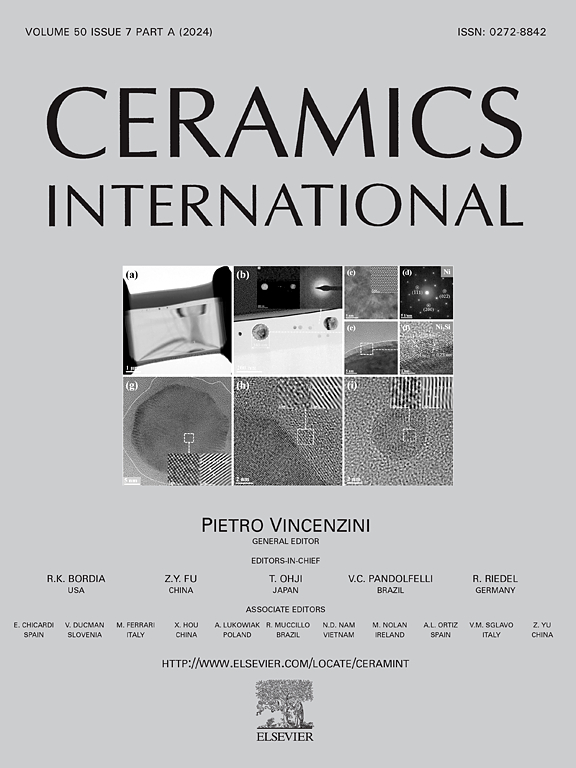部分去除sp2壳层的二氧化硅和爆轰纳米金刚石的大块复合材料
IF 5.1
2区 材料科学
Q1 MATERIALS SCIENCE, CERAMICS
引用次数: 0
摘要
具有杂质-空位中心的钻石是一种有吸引力的微光子学材料,可以用作单光子发射器。具有内禀单氮空位(NV)中心的爆轰纳米金刚石(DNDs)价格低廉,适合批量生产。本文提出了一种方法来克服dnd的两个主要性质:团聚倾向和每个爆轰纳米金刚石颗粒周围存在sp2杂化碳厚壳。结果表明,在250℃压缩至7.5 GPa时,具有均匀分布的单金刚石纳米晶的SiO2气凝胶不可逆地转变为致密的化学惰性材料。随后在7.5 GPa和600°C的氢气气氛中处理该材料,使二氧化硅基体中的悬垂键钝化,并消除其寄生发光。氢化作用也在很大程度上去除了dnd的sp2壳层,并将它们的中性NV0中心转化为更有用的带负电荷的NV -中心。在制备致密dds /SiO2复合材料的每个阶段后,用x射线衍射、红外光谱和拉曼光谱对材料进行了检测。本文章由计算机程序翻译,如有差异,请以英文原文为准。
Bulk composite of silica and detonation nanodiamonds with partially removed sp2 shells
Diamonds with impurity-vacancy centers are an attractive material for microphotonics and can be used, for example, as single photon emitters. Detonation nanodiamonds (DNDs) with intrinsic single nitrogen-vacancy (NV) centers are cheap and suitable for mass production. This paper proposes a way to overcome the two main properties of the DNDs: the tendency to agglomeration and the presence of a thick shell of sp2-hybridized carbon around each detonation nanodiamond particle. It is shown that SiO2 aerogel with uniformly distributed single diamond nanocrystals compressed to 7.5 GPa at 250 °C irreversibly transforms into a dense and chemically inert material. Subsequent treatment of this material in a hydrogen atmosphere at 7.5 GPa and 600 °C passivates dangling bonds in the silica matrix and eliminates its parasitic luminescence. The hydrogenation also largely removes the sp2 shells from DNDs and converts their neutral NV0 centers into more useable negatively charged NV− centers. After each stage of preparing the dense DNDs/SiO2 composite, the material was examined by X-ray diffraction and Infrared and Raman spectroscopy.
求助全文
通过发布文献求助,成功后即可免费获取论文全文。
去求助
来源期刊

Ceramics International
工程技术-材料科学:硅酸盐
CiteScore
9.40
自引率
15.40%
发文量
4558
审稿时长
25 days
期刊介绍:
Ceramics International covers the science of advanced ceramic materials. The journal encourages contributions that demonstrate how an understanding of the basic chemical and physical phenomena may direct materials design and stimulate ideas for new or improved processing techniques, in order to obtain materials with desired structural features and properties.
Ceramics International covers oxide and non-oxide ceramics, functional glasses, glass ceramics, amorphous inorganic non-metallic materials (and their combinations with metal and organic materials), in the form of particulates, dense or porous bodies, thin/thick films and laminated, graded and composite structures. Process related topics such as ceramic-ceramic joints or joining ceramics with dissimilar materials, as well as surface finishing and conditioning are also covered. Besides traditional processing techniques, manufacturing routes of interest include innovative procedures benefiting from externally applied stresses, electromagnetic fields and energetic beams, as well as top-down and self-assembly nanotechnology approaches. In addition, the journal welcomes submissions on bio-inspired and bio-enabled materials designs, experimentally validated multi scale modelling and simulation for materials design, and the use of the most advanced chemical and physical characterization techniques of structure, properties and behaviour.
Technologically relevant low-dimensional systems are a particular focus of Ceramics International. These include 0, 1 and 2-D nanomaterials (also covering CNTs, graphene and related materials, and diamond-like carbons), their nanocomposites, as well as nano-hybrids and hierarchical multifunctional nanostructures that might integrate molecular, biological and electronic components.
 求助内容:
求助内容: 应助结果提醒方式:
应助结果提醒方式:


